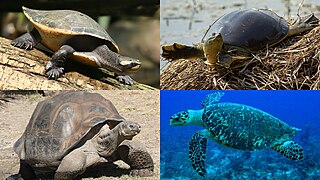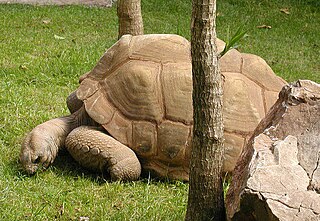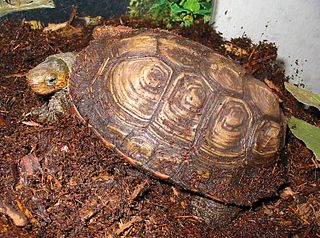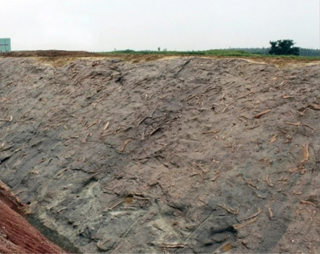
Turtles are reptiles of the order Testudines, characterized by a special shell developed mainly from their ribs. Modern turtles are divided into two major groups, the Pleurodira and Cryptodira, which differ in the way the head retracts. There are 360 living and recently extinct species of turtles, including land-dwelling tortoises and freshwater terrapins. They are found on most continents, some islands and, in the case of sea turtles, much of the ocean. Like other amniotes they breathe air and do not lay eggs underwater, although many species live in or around water.

Emydidae is a family of testudines (turtles) that includes close to 50 species in 10 genera. Members of this family are commonly called terrapins, pond turtles, or marsh turtles. Several species of Asian box turtles were formerly classified in the family; however, revised taxonomy has separated them to a different family (Geoemydidae). As currently defined, the Emydidae are entirely a Western Hemisphere family, with the exception of two species of pond turtle.

The Cryptodira are a suborder of Testudines that includes most living tortoises and turtles. Cryptodira differ from Pleurodira in that they lower their necks and pull the heads straight back into the shells, instead of folding their necks sideways along the body under the shells' marginals. They include among their species freshwater turtles, snapping turtles, tortoises, softshell turtles, and sea turtles.

Peltephilus, the horned armadillo, is an extinct genus of armadillo xenarthran mammals that first inhabited Argentina during the Oligocene epoch, and became extinct in the Miocene epoch. Notably, the scutes on its head were so developed that they formed horns. Aside from the horned gophers of North America, it is the only known fossorial horned mammal. P. ferox had skull about 11.7 centimetres (4.6 in), and estimated body mass is around 11.07 kilograms (24.4 lb).

Testudinoidea is a superfamily within the suborder Cryptodira of the order Testudines. It includes the pond turtles, Asian turtles, the monotypic big-headed turtle, and the tortoises.

Rhinoclemmys is a genus of turtles in the family Geoemydidae, the only genus in the subfamily Rhinoclemmydinae. Member species of the genus are commonly known as the Neotropical wood turtles and are the only geoemydids known from the Americas. As such, they have adapted to a wide range of habitats, which is reflected in the species' common names.

Hesperotestudo is an extinct genus of tortoise native to North and Central America from the Early Miocene to the Late Pleistocene. Species of Hesperotestudo varied widely in size, with a large undescribed specimen from the Late Pleistocene of El Salvador reaching 150 cm (4.9 ft) in carapace length, larger than that of extant giant tortoises. Historically considered a subgenus of Geochelone, it is now considered to be distantly related to that genus. Its relationships with other tortoises are uncertain. The exposed areas of the bodies of Hesperotestudo species were extensively covered with large dermal ossicles, which in life were covered in keratin. It has been suggested that species of Hesperotestudo were relatively tolerant of cold weather. Hesperotestudo became extinct at the end of the Pleistocene roughly co-incident with the arrival of the first humans in North America. There is apparently a site in Florida where one individual may have been killed that some suggested were evidence of butchering, although others suggested that the turtle was neither cooked nor does a ledge that was found near it date at the same time as it.
Emarginachelys cretacea is a turtle belonging to the group Cryptodira, known from well preserved fossils from the Maastrichtian stage of the Late Cretaceous of Montana. Its exact phylogenetic position within Cryptodira is uncertain; different authors considered it to be either the earliest described chelydrid or a fossil relative of kinosternoids.

The Wangshi Group is a geological Group in Shandong, China whose strata date back to the Coniacian to Campanian stages of the Late Cretaceous. Dinosaur remains are among the fossils that have been recovered from the group.

Hadrianus is an extinct genus of tortoise belonging to the Testudinidae found in the United States, the Yolomécatl Formation of Mexico, the Alai Beds of Kyrgyzstan and Spain and believed to be the oldest true tortoise known. The genus is thought to be closely related to the genus Manouria. The genus may have evolved in the subtropics of Asia and subsequently migrated to North America and Europe. Evangelos Vlachos (2018) reassessed the North American species attributed to the genus, and determined only two as accepted namely H. corsoni & H. majusculus. The remaining species were identified as either junior synonyms, moved to other genera or considered nomen dubium do to incomplete fossils.

Acherontemys is an extinct genus of turtle from Eocene sediments in northwestern North America and comprising a single species Acherontemys heckmani. Acherontemys has been placed within the pond turtle superfamily Testudinoidea as part of the clade Pan-Emydidae.

Pangshura is a genus of geoemydid turtles endemic to South Asia. Its member species were formerly in the obsolete genus Kachuga. A fifth member, Pangshura tatrotia, was described in 2010, but it is only known from Pliocene fossils.

Echmatemys is an extinct genus of geoemydid turtle from the Eocene of North America. It is the oldest North American geoemydids, and is one of the most common early Eocene turtles.
Haichemydidae is an extinct family of turtles that belongs to the superfamily Testudinoidea. Its only genus is Haichemys.
Sinochelyidae is an extinct family of Testudinoidea turtles found in China.

Americhelydia is a clade of turtles that consists of sea turtles, snapping turtles, the Central American river turtle and mud turtles, supported by several lines of molecular work. Prior to these studies some morphological and developmental work have considered sea turtles to be basal members of Cryptodira and kinosternids related to the trionychians in the clade Trionychoidea. Americhelydia and Testudinoidea, both clades within Durocryptodira, split a part during the early Cretaceous.
Shandongemys is an extinct genus of turtle from the Late Cretaceous Wangshi Group of Shandong, China, and the type species is S. dongwuica. The holotype is ZCDM V0050.
A mental gland is a part of the body found in many species of amphibians and reptiles. Mental glands produce chemicals that conspecific animals use to communicate.
Pangshura tatrotia is an extinct species of turtle belonging to the family Geoemydidae. It is known from the Early Pliocene of the Tatrot Formation near Padhri in Pakistan. It is known from a single specimen, a fossil shell collected in 1932 or 1933 by a Yale University expedition. It is similar to living species of Pangshura, but differs in details of shell anatomy.












